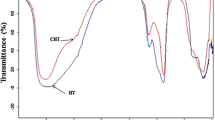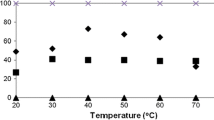Abstract
Research on the epoxidation of diallyl ether (DAE) to allyl-glycidyl ether with 30 wt% hydrogen peroxide and in the presence of the TS-1 catalyst is presented. In this work, methanol was tested as the solvent. The influence of the following parameters was studied: the temperature 25–80 °C, the molar ratio of DAE/H2O2 0.25:1–5:1, the solvent concentration 10–90 wt%, the content of the TS-1 catalyst 1–9 wt% and the reaction time 15–240 min. Because the effective conversion of hydrogen peroxide was relatively low during the studies, after establishing the most beneficial conditions for the epoxidation of DAE, the influence of an addition of the chosen inorganic salt—KH2PO4 on the effective conversion of hydrogen peroxide and other functions characterized this process was also tested.






Similar content being viewed by others
References
Wang R, Guo X, Wang X, Hao J (2003) Propylene epoxidation over silver supported on titanium silicalite zeolite. Catal Lett 90(1–2):57–63
Lee W-S, Akatay C, Stach EA, Ribeiro FH, Delgass WN (2014) Gas-phase epoxidation of propylene in the presence of H2 and O2 over small gold ensembles in uncalcined TS-1. J Catal 313:104–112
Danov SM, Sulimov AV, Sulimova AV (2008) Solvent effect on epoxidation of allyl chloride with hydrogen peroxide on titanium-containing silicalite. Russ J Appl Chem 81(11):1963–1966
Xia H, Zhou C-H, Tong D, Chen J, Yu W, Liu S (2011) Preparation and catalysis in epoxidation of allyl chloride of zeolitic titanosilicate-1/smectitic clay minerals. Appl Clay Sci 53:279–287
Hutchings GJ, Lee DF, Minihan AR (1995) Epoxidation of allyl alcohol to glycidol using titanium silicalite TS-1: effect of the method of preparation. Catal Lett 33:369–385
Wróblewska A, Fajdek A (2010) Epoxidation of allyl alcohol to glycidol over the microporous TS-1 catalyst. J Hazard Mater 179:258–265
Wróblewska A, Makuch E (2012) The utilization of Ti-SBA-15 catalyst in the epoxidation of allylic alcohols. Reac Kinet Mech Cat 105:451–468
Wu P, Liu Y, He M, Tatsumi T (2004) A novel titanosilicate with MWW structure: catalytic properties in selective epoxidation of diallyl ether with hydrogen peroxide. J Catal 228:183–191
Thangaraj A, Kumar R, Ratnasamy P (1990) Direct catalytic hydroxylation of benzene with hydrogen peroxide over titanium—silicate zeolites. Appl Catal 57:L1–L3
Wróblewska A (2014) The epoxidation of limonene over the TS-1 and Ti-SBA-15 catalysts. Molecules 19:19907–19922
Yoon ChW, Hirsekorn KF, Neidig ML, Yang X, Tilley TD (2011) Mechanism of the decomposition of aqueous hydrogen peroxide over heterogeneous TiSBA15 and TS-1 selective oxidation catalysts: insights from spectroscopic and density functional theory studies. ACS Catal 1:1665–1678
Guidotti M, Pirovano C, Ravasin N, Lazaro B, Fraile JM, Mayoral JA, Coq B, Galarneau A (2009) The use of H2O2 over titanium-grafted mesoporous silica catalysts: a step further towards sustainable epoxidation. Green Chem 11:1421–1427
Fraile JM, Garcia JI, Mayoral JA, Vispe E (2003) Optimization of cyclohexene epoxidation with dilute hydrogen peroxide and silica-supported titanium catalysts. Appl Catal A 245:363–376
Fan W, Wu P, Tatsumi T (2008) Unique solvent effect of microporous crystalline titanosilicates in the oxidation of 1-hexene and cyclohexene. J Catal 256:62–73
Antcliff KL, Murphy DM, Griffiths E, Giamello E (2003) The interaction of H2O2 with exchanged titanium oxide systems (TS-1, TiO2, [Ti]-APO-5, Ti-ZSM-5). Phys Chem Chem Phys 5:4306–4316
Jiang T, Wang W, Han B (2013) Catalytic hydroxylation of benzene to phenol with hydrogen peroxide using catalysts based on molecular sieves. New J Chem 37:1654–1664
Ediati R, Ulfa M, Fansuri H, Ramli Z, Nur H, Prasetyoko D (2014) Influence of TiO2/TS-1 calcination on hydroxylation of phenol. J Math Fund Sci 46(1):76–90
Kholdeeva OA, Trukhan NN (2006) Mesoporous titanium silicates as catalysts for the liquid-phase selective oxidation of organic compounds. Russ Chem Rev 75(5):411–432
Author information
Authors and Affiliations
Corresponding author
Rights and permissions
About this article
Cite this article
Wróblewska, A., Drewnowska, E. & Gawarecka, A. The epoxidation of diallyl ether to allyl-glycidyl ether over the TS-1 catalyst. Reac Kinet Mech Cat 118, 719–731 (2016). https://doi.org/10.1007/s11144-016-1028-3
Received:
Accepted:
Published:
Issue Date:
DOI: https://doi.org/10.1007/s11144-016-1028-3




